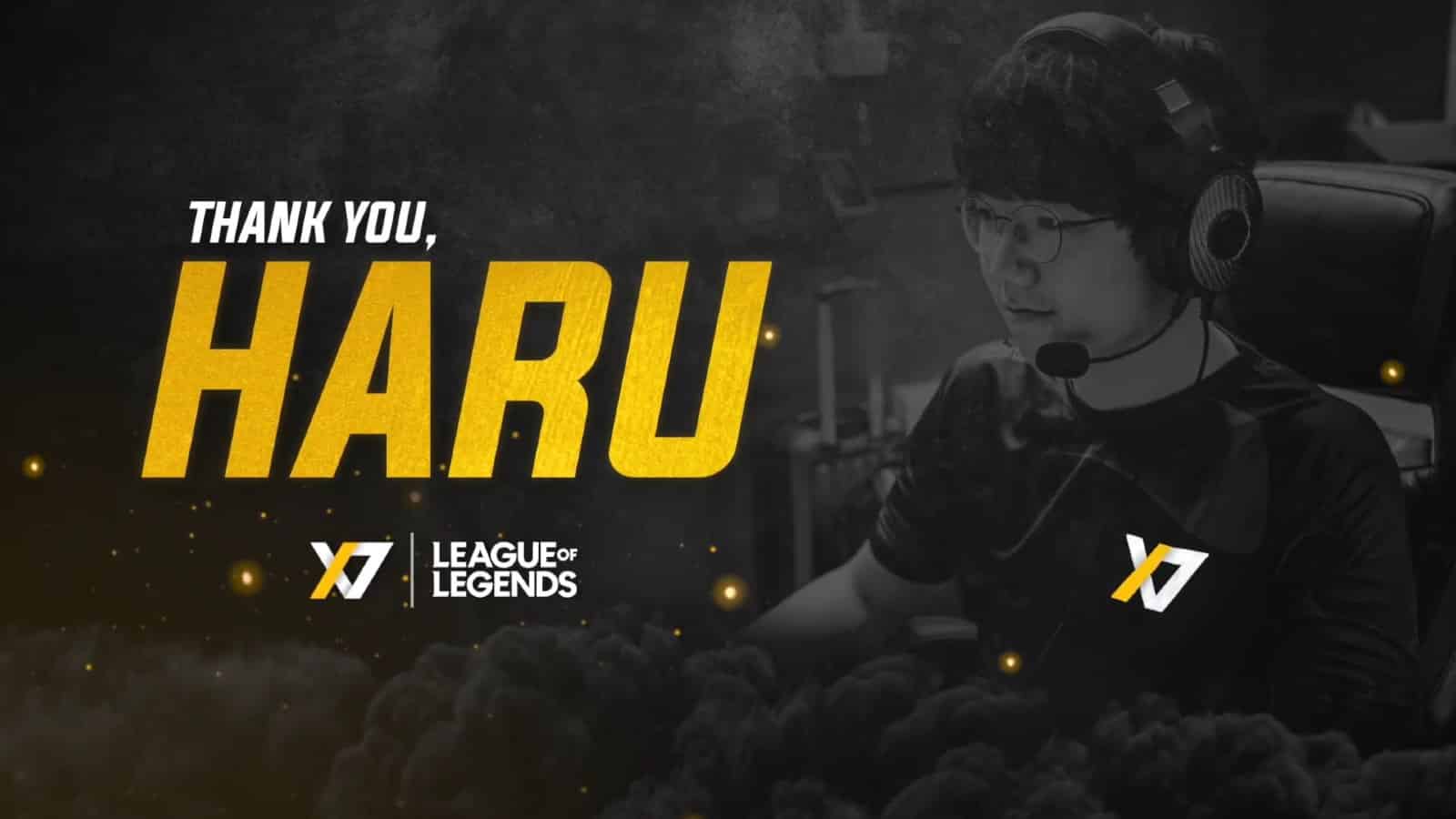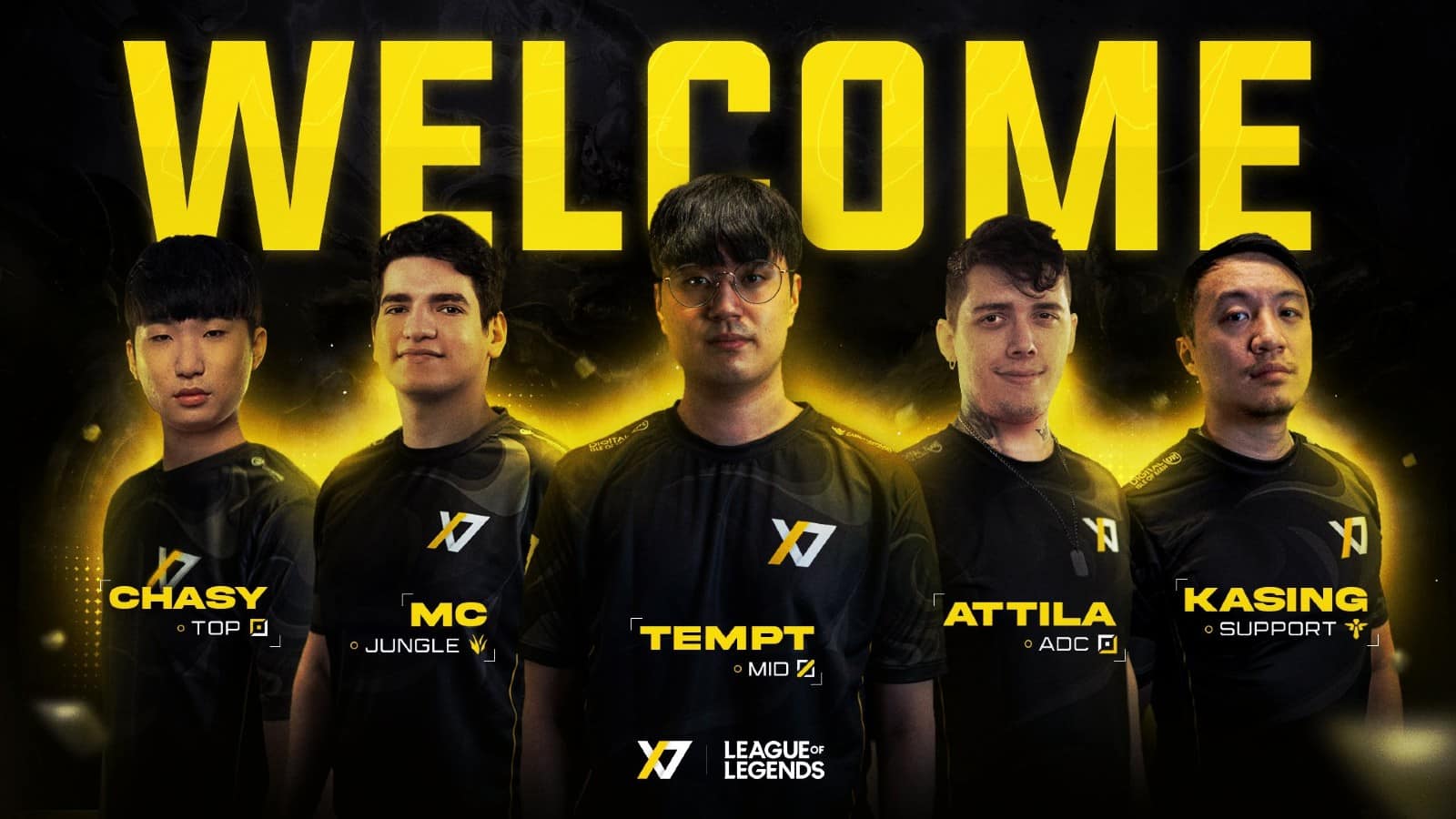Inside the Offseason: How X7 propelled Haru from the NLC to Team Vitality
 X7 Esports
X7 EsportsX7 Esports want to do things differently in League of Legends’ ERL system. They entered the NLC in 2021 with the goal of becoming the premier destination for overseas talent looking to make it to the LEC – and now, only one split on from their debut, they’re beginning to make that goal a reality.
X7 CEO Josh ‘Hyrav’ Kingett entered the world of League of Legends esports with a clear mission statement. Back in 2021, he told Dexerto how he wanted to “import foreign talent across and then offload them to franchise teams”.
With the signings of former LCK stars Kim ‘Haru’ Min-seung and Kang ‘Tempt’ Myung-gu, the initial stages of that plan were put into place in December 2021. And now, less than seven months on from that initial investment, X7 have already seen a return, facilitating a transfer for Haru to become the new jungler for LEC organization Team Vitality.
The move makes Haru one of the only Korean players currently competing in the LEC, as organizations in the region have recently begun to look more towards homegrown talent from the ERL system to make up their rosters.
He replaces long-time EU fan-favorite Oskar ‘Selfmade’ Boderek after a disappointing failure by Vitality’s so-called ‘EU superteam’ in the Spring split, where they scraped their way into a playoffs spot before being eliminated in the second round of the losers’ bracket.
LEC Roster update ⬇️ pic.twitter.com/DVXpZzQRN5
— Team Vitality 🐝 (@TeamVitality) June 6, 2022
Haru comes in as the only roster move of the offseason for Vitality, with the responsibility of turning around one of the most disappointing failures in competitive League of Legends this year, in what is only his second split in Europe.
But regardless of how he performs, he’s the first piece of proof that X7’s business model can succeed, and may very well set a new precedent for the infrastructure of imports in Europe.
Offseason discussions
But how exactly were X7 able to flip a player’s contract in only one split, and to one of the most high-profile teams in Europe?
According to Hyrav, Vitality expressed their initial interest in Haru towards the end of April 2022 – shortly after the end of their disastrous playoffs run. Hyrav explained how the initial request involved “access to solo queue vods and the ability to speak directly with Haru,” and that these talks lasted until early May when the deal was ultimately finalized and the transfer was made.
Haru was one of the best-performing junglers in the ERL ecosystem in the Spring split – winning the NLC with only six losses throughout the course of the regular season and playoffs. The team failed to entirely live up to their potential at EU Masters, but it’s clear that Vitality saw promise in him despite a lackluster EUM showing.
The buyout for Haru, as set by X7, was “somewhere between €100K-€200K”. According to Hyrav, X7’s buyout valuations were locked from the beginning of the Spring split, but moving forward they’re looking to implement a “scalable buyout that can change based on player performance”. Seeing as their business model revolves around their ability to negotiate these buyouts, this scaling system is an important step for X7 in developing their ‘develop players and facilitate transfers’ model.
What can Haru do at Vitality?
It’s abundantly clear that Vitality need nothing short of a miracle if they want to rebuild community faith after their Spring disaster. Their communication looked almost nonexistent throughout the latter half of Spring, and for players of this rosters’ caliber, a failure to make Worlds in Summer should be considered unacceptable.
Selfmade has always been more of a carry player, and that’s been Vitality’s issue. It’s a team with a carry player in almost every role, in a game where resources are finite and have to be distributed unevenly to allow one or two players to take the responsibility for damage output. It was abundantly clear in Spring that this was something Vitality struggled to do – and while Haru’s looked at home on carries in the NLC, he’s no stranger to playing supportively.
Heartbreaking decision taken by all the members of the team for the best. Thank you to my little brother @selfmade_LoL for your professionalism and your talent.
— Fabien 'Neo' Devide (@Vitality_Neo) June 6, 2022
Unfortunately for Selfmade, being a good player sometimes isn’t enough. You have to be both a good player, and the kind of good player that will fit the requirements of the rest of your team. And if that’s not possible, it’s clear that there are a multitude of talented players who are ready and waiting to take your place.
And if X7 are able to make their gamble work, those players won’t just be Europeans – they’ll be from an open market of LCK and LCK CL players looking to make it in Europe.
What does this transfer mean for X7?
 X7 Esports
X7 EsportsX7 are looking to fill an interesting, as yet unexplored corner of the League of Legends esports market. As Hyrav puts it, they want to provide “franchise teams with an ‘ERL pricetag’ for LCK/LPL players”, something that’s not really existed in the EU ecosystem before now.
The discussion of imports in Western League of Legends is an ongoing debate that’s swung wildly from one extreme to the other throughout the course of League’s short history. Currently, it feels as though European teams are tending towards domestic as opposed to overseas talent
And Haru wasn’t the only X7 player who received interest in the Spring offseason. Hyrav revealed that mid laner Tempt also saw inquiries from LEC and LCS teams. Those negotiations ultimately fell through, with the interested LCS team opting for a player with a lower buyout and the LEC team looking to a European mid laner rather than an import.
So, for now, Tempt remains. But the cogs at X7 continue to turn, with the team bringing in more Korean representatives in the offseason in the form of top laner Kim ‘Chasy’ Donghyeon and substitute mid laner Seo ‘SlowQ’ Yebit.
According to Hyrav, Chasy has already drawn the attention of multiple teams after only a few weeks competing in the NLC. X7’s model of developing and acclimatizing import players is something wholly new to Europe, and there’s no telling how it will pay off in the long term – but for now, at least, it appears to be paying off.